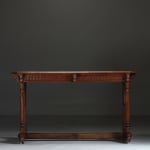-
Artworks
Writing Table , c.1870 (sold)
AN ENGLISH GOTHIC-REVIVAL WALNUT WRITING TABLE
THE DESIGN ATTRIBUTABLE TO A.W.N. PUGIN (1812-1852), MID-19TH CENTURY
The canted angle top inset with leather writing surface above an imbricated frieze with tusk tenon joint ends, supported on chamfered arched trestles with inlaid petal roundels to the horizontal side stretchers above castors, further joined by a central stretcher with central carved petal roundel.
Height: 68cm
Width: 139cm
Depth: 48cmFurther images
-
(View a larger image of thumbnail 1
)

-
(View a larger image of thumbnail 2
)

-
(View a larger image of thumbnail 3
)

-
(View a larger image of thumbnail 4
)

-
(View a larger image of thumbnail 5
)

-
(View a larger image of thumbnail 6
)

-
(View a larger image of thumbnail 7
)

-
(View a larger image of thumbnail 8
)

-
(View a larger image of thumbnail 9
)

-
(View a larger image of thumbnail 10
)

-
(View a larger image of thumbnail 11
)

-
(View a larger image of thumbnail 12
)

-
(View a larger image of thumbnail 13
)

-
(View a larger image of thumbnail 14
)

-
(View a larger image of thumbnail 15
)

-
(View a larger image of thumbnail 16
)

-
(View a larger image of thumbnail 17
)

-
(View a larger image of thumbnail 18
)

The striking architectural nature of this table, combined with the exposed constructional forms and gothic details point towards the hand of Augustus Welby Northcote Pugin, often celebrated as the doyen of the Gothic Revival in England. He’s formative career started at an incredibly early age, when he assisted his father, Augustus Charles Pugin, an architectural draughtman, in meticulously recording gothic material from French medieval buildings, abbeys and chateaux around Normandy. These findings and other designs by his father and probably the younger Pugin were published from 1825 to 1827 in Rudolph Ackermann’s periodical, The Repository of Arts. Subsequently, at the age of only 15 years in 1827, A.W.N Pugin joined a commission run by Morel and Seddon to furnish the new Wyattville apartments for the George IV at Windsor Castle. He was employed specifically to ‘design and make working drawings for the gothic furniture of Windsor Castle’ for the sum of £1 1s. a day. This achievement set him apart; his use of the ‘gothic’ established him as far more original and imaginatively flamboyant designer in sharp contrast to his mundane contemporaries. It also marked a period as he evolved into an architect-designer moving towards a confidently sober and bolder application of the ‘gothic’ with simplified results from the 1830s into the 40s, culminating in his defining and largest commission at the Palace of Westminster from 1847 to 1852.
Success also led him to establish his own workshop in 1829, although bankrupt by 1831 it was an informative experience. He learnt the practical side of his craft and trade; constructional cabinet making and carving. This is echoed in his practical use of the tusked tenon and mortise joinery prominently used throughout and incorporated as a feature. As the 1830s progressed he became more pre-occupied by architecture, whilst also continuing his quest to seek out medieval and Renaissance prototypes. The imbricated detail of this table’s frieze reflects this aspect of Pugin’s interest, together with a progression towards a structural gothic style using the pointed arch feature or braces, as if the table were the exterior of timbered house. Finally, the smaller details reflect Pugin’s all encompassing approach to design; the inlaid roundels are reminiscent of his ceramic designs, produced by Minton, and in particular the Tudor rose readily found on encaustic tile patterns.
By the 1840s there were a number of highly proficient manufacturers within the furniture trade such as John Webb, Crace, Myers, Gillow and Holland, who were working to Pugin’s designs. His thoughts and legacy were widely disseminated through numerous publications, one of the most famous being The True Principles.
Vagabond Antiques presents a 19th century oak writing table in the manner of A.W.N Pugin -
(View a larger image of thumbnail 1
)

















